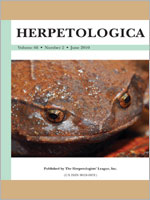Habitat availability for larval development is one of the main factors affecting the distribution of anuran species. However, little is known about the spatial distribution of these habitats, and estimates of the number of available ponds for a given reserve size are not available in Amazonia. Temporary water bodies were surveyed in a 30-m strip around a 144-km system of trails in a terra firme tropical forest, and tadpoles were collected to evaluate differences in species composition between isolated and streamside ponds. More than 90% of the ponds were <150 m from a stream, and the tadpole species composition differed between isolated and streamside ponds. Isolated ponds were less common, but were, on average, more stable in time than streamside ponds. Despite the limited distribution of isolated forest ponds, species of frogs dependent on them were found throughout the reserve. The presence of both types of ponds is important for the maintenance of the local pond-breeding anuran community. This study shows that isolated and streamside forest ponds maintain a distinct assemblage of frogs, and isolated ponds are much less common, but are, on average, more predictable in time than streamside ponds.
How to translate text using browser tools
1 June 2010
Temporary Pond Availability and Tadpole Species Composition in Central Amazonia
Domingos J. Rodrigues,
Albertina P. Lima,
William E. Magnusson,
Flávia R. C. Costa
ACCESS THE FULL ARTICLE

Herpetologica
Vol. 66 • No. 2
June 2010
Vol. 66 • No. 2
June 2010
conservation
frogs
Reserve design
riparian zone
spatial scales
temporary waters




